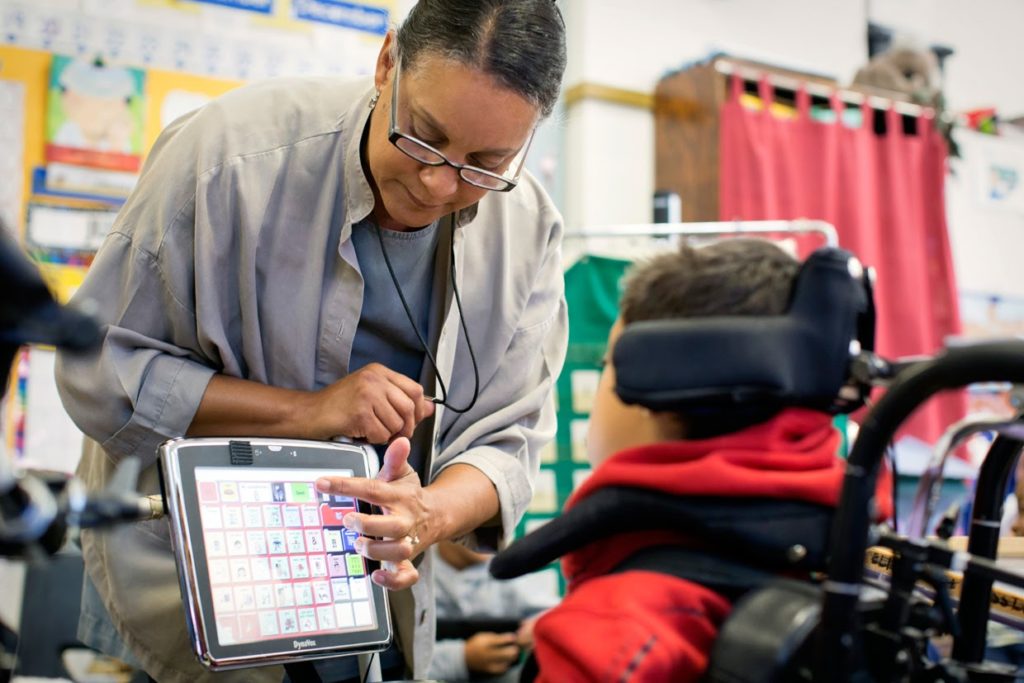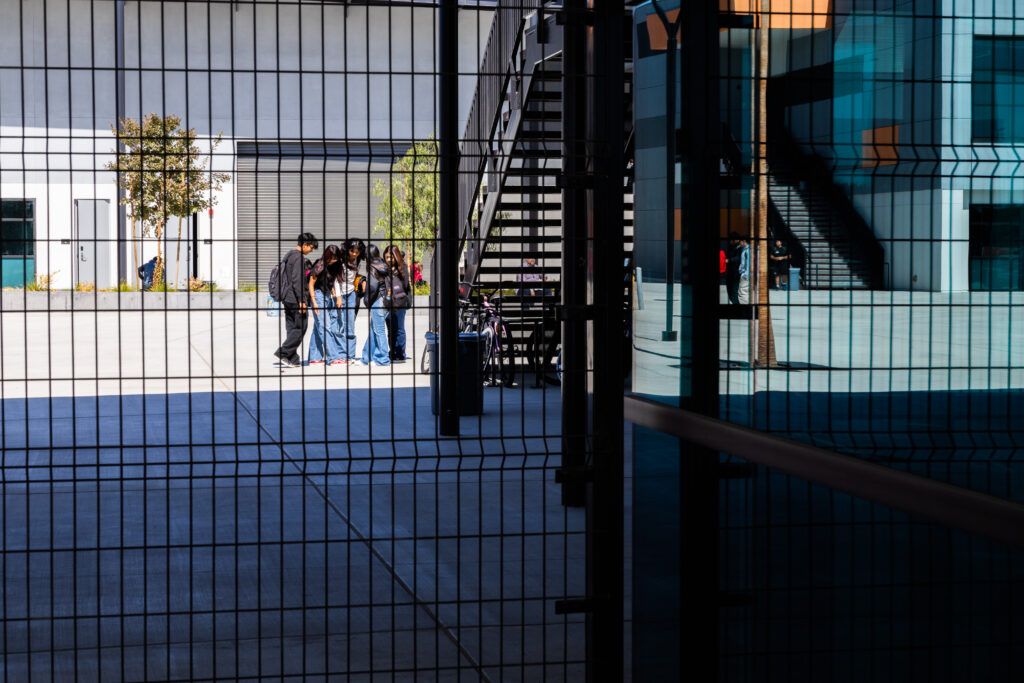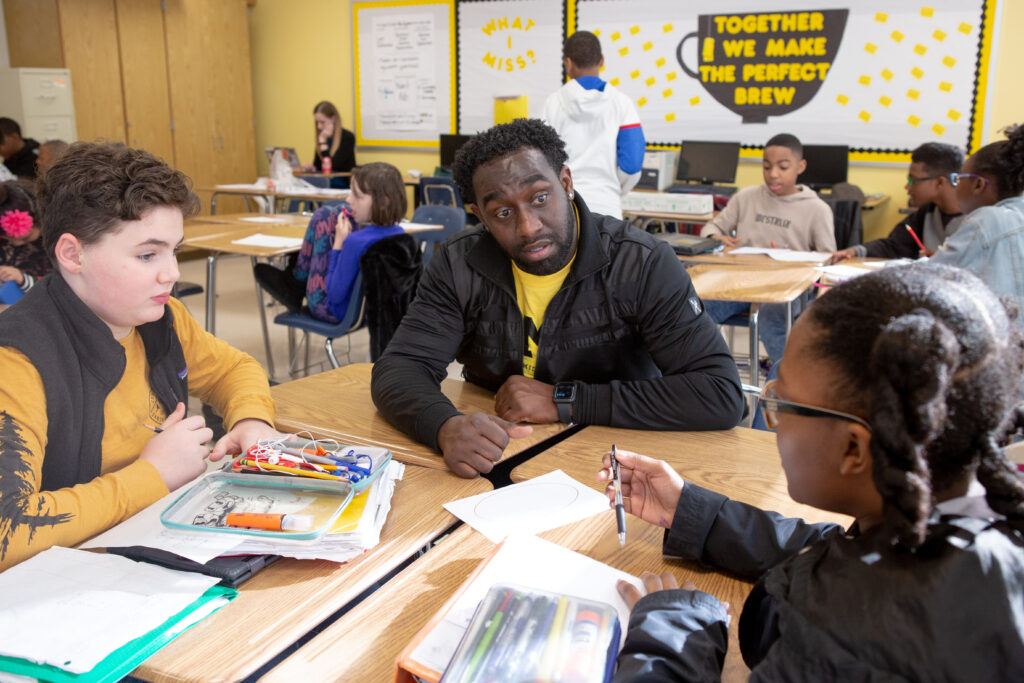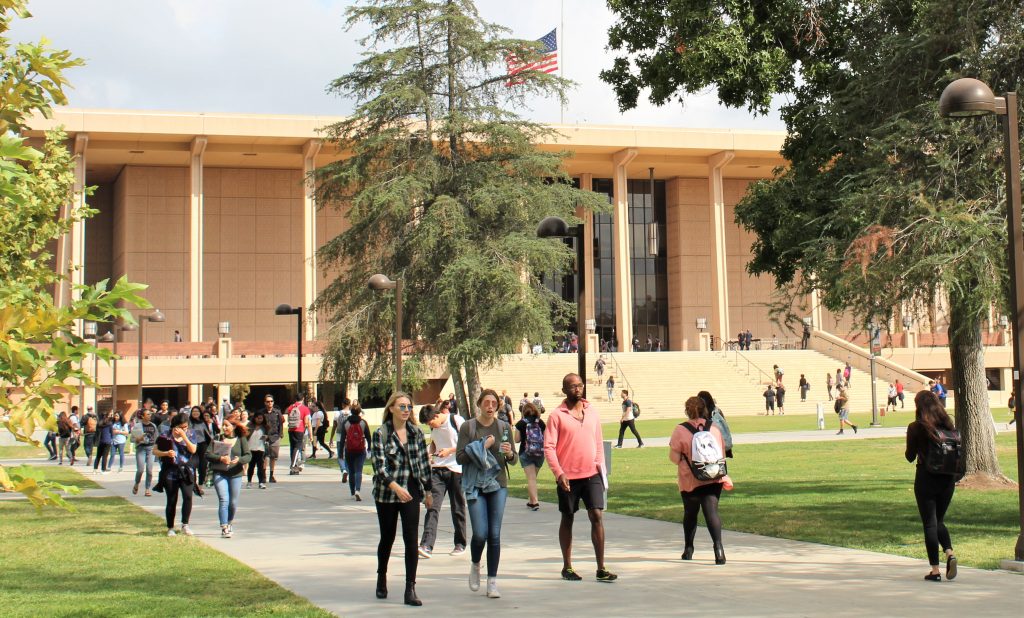
A sixth-grade math teacher helps two students during a lesson about math and music.
Credit: Allison Shelley / EDUimages
Top Takeaways
- The president dismissed many programs as outdated or “woke.”
- Advocates for English learners argue that the cuts will reverse progress.
- The initial budget will face resistance from Democrats and maybe some Republicans.
President Donald Trump would maintain funding levels for students with disabilities and for Title I aid for low-income students while wiping out long-standing programs serving migrant children, teachers in training, college-bound students, English learners and adult learners in the education budget for fiscal 2026.
Trump’s “skinny budget,” which he released on Friday, would cut $12 billion or about 15% of K-12 and some higher education programs administered by the U.S. Department of Education. It contains sparse, sometimes dismissive, language explaining why he is eliminating programs and offers no details about plans to consolidate $6.5 billion in 18 unspecified programs into a single $2 billion grant program.
“K-12 outcomes will improve as education returns to the states, which would make remedial education for adults less necessary,” according to the one-paragraph explanation for the full $729 million cut to adult education.
The budget summary justified eliminating funding for programs like Upward Bound and GEAR UP, which focus on increasing the college and career readiness of low-income students, as “a relic of the past when financial incentives were needed to motivate Institutions of Higher Education to engage with low-income students and increase access.”
“I don’t think the budget request reflects a deep understanding of what the programs are and what they do. The language is designed to capture headlines, not hearts and minds,” said Reg Leichty, founding partner of Washington, D.C.-based Foresight Law + Policy, which advises education groups, including the Association of California School Administrators, on congressional education policies.
“(Trump) has eliminated programs that it’s taken decades to build,” said U.S. Rep. Mark DeSaulnier, a California Democrat serving the East Bay. “There’s been no analysis of what the financial assessment would mean to the communities served. You can always find more efficiencies, but just cutting everything is just mindless.”
Only charter schools would receive more money — $60 million to bring the total federal spending on charter schools to $500 million.
The U.S. Department of Education spent about $150 billion in fiscal 2024 on programs in states and school districts, of which California received $18.6 billion, according to the Pew Research Center.
Trump’s initial budget is the first step in what will likely be a lengthy and contentious process in Congress before the new fiscal year begins Oct. 1.
“It’s not a budget reflective of the perspectives of many Republicans on Capitol Hill. We’ll see how they try to accommodate the administration,” said Leichty. “It’s a different Congress, it’s a different moment, but still, cuts of this scale and scope are hard to imagine how even the House (with a tiny Republican majority) would pass them.”
The two largest federal K-12 programs — Title I grants of $18.4 billion and $15.5 billion for the Students with Disabilities Act — reach every school district nationwide and have bipartisan support, but Trump has proposed reshaping both programs as block grants administered by states with less oversight and more local control — actions requiring congressional approval.
“With a budget that cuts the Department of Education by so much, we’re really pleased to see it does not cut funding for IDEA,” said Kuna Tavalin, senior policy and advocacy adviser for the Council for Exceptional Children, referring to the Individuals with Disabilities Education Act. “Of course, the devil is in the details.”
The federal government funds programs that support students with disabilities from early childhood through 21 years old. Consolidation raises the specter that funding for some stages may be fungible, which “could potentially be really damaging,” Tavalin said.
“This raises the hair on the back of my neck,” he said.
Programs that Trump would abolish include:
- TRIO organizations like Upward Bound and GEAR UP, $1.579 billion.
- English language acquisition through Title III, $890 million.
- Migrant education, $428 million
- Teacher quality partnerships, $70 million
- Federal work-study, $980 million
- Preschool development grants, $315 million
The budget proposal also calls for cutting $49 million from the Department of Education’s Office of Civil Rights. The office would shift the focus from enforcing Title IX and programs with goals of raising achievement for minority students to carrying out presidential executive orders and ending the office’s “ability to push DEI programs and promote radical transgender ideology.”
The budget is silent on several significant programs, including Head Start, research funding through the Institute of Education Sciences, the Child Care and Development Block Grant, and the state assessment program.
Reactions
Title III
This funding helps English learners and immigrant students learn to speak, read, and write English fluently, learn other subjects such as math and science, and meet graduation requirements. California received about $157 million in 2024-25 from Title III.
Students who are not yet fluent in English when they begin school are entitled under federal law to get help to learn the language.
According to the budget, “To end overreach from Washington and restore the rightful role of state oversight in education, the Budget proposes to eliminate the misnamed English Language Acquisition program, which actually deemphasizes English primacy by funding (non-profit organizations) and states to encourage bilingualism.”
Advocates for English learners disputed the reasoning.
“The claim that Title III ‘deemphasizes English primacy’ ignores decades of research and legal precedent,” said Anya Hurwitz, executive director of SEAL (Sobrato Early Academic Language), a nonprofit organization. “Supporting bilingualism does not come at the expense of English proficiency — it enhances it.”
“Without these funds, many schools will be forced to abandon evidence-based strategies that work and cut services,” said Martha Hernandez, executive director of Californians Together. She said that without targeted support, more students may take longer to learn English and become “long-term English learners” who struggle to thrive in middle and high school.
Migrant education
The Migrant Education Program supports children of agricultural, dairy, lumber, and fishing workers who have moved during the past three years. California received $120 million for this program in 2024-25.
Debra Duardo, superintendent of schools in Los Angeles County, wrote in an email that the loss of these funds will drastically reduce academic support and widen academic achievement gaps. “This decision would have devastating impacts on Los Angeles County schools, where we serve one of the nation’s largest populations of English learners and children from migrant families,” she said.
Preschool Development Grants
These programs help states improve their preschool and child care programs, for example, by conducting needs assessments, teacher training and quality improvement. California received Preschool Development Grants in the past, but is not currently a grantee. However, eliminating the grant program could impact California in the future, said Donna Sneeringer, vice president and chief strategy officer for Child Care Resource Center, a nonprofit organization based in Los Angeles that was a partner in the state’s last preschool development grant.
“There’s still work to be done,” Sneeringer said. “California has made significant changes in our early learning landscape. With transitional kindergarten being available to all 4-year-olds, there are a lot of changes that our child care and early learning providers are having to go through.”
In the budget proposal, the Trump administration called Preschool Development Grants “unproductive” and said they had been “weaponized by the Biden-Harris Administration [sic] to extend the federal reach and push DEI policies on to toddlers.
Adult education
Unlike K-12 schools, adult education is heavily reliant on federal funding. Sharon Bonney, CEO of the Coalition on Adult Basic Education, said she found the proposed cuts “shocking” and fears the cuts would mean adult schools would rely on volunteers rather than trained teachers. She believes that this is a part of the Trump immigration agenda — 6 out of 10 adult education students are immigrants.
Adult schools offer career education or training, but much of their programming is aimed at helping immigrants assimilate and prepare for the citizenship test or learning English as a second language.
Teacher quality grants
Federal funding for the Teacher Quality Partnership grant helps recruit and train teachers for high-needs schools and for hard-to-fill teaching positions.
University, school district and nonprofit teacher preparation programs use grants from the $70 million fund to recruit and train teacher candidates for high-needs schools and hard-to-fill teaching positions, and sometimes to offer them stipends and other financial help.
“These abrupt, short-sighted cuts will directly disrupt critical teacher residency programs that were actively preparing new educators for high-need positions in urban and rural districts across the state,” said Marvin Lopez, executive director of the California Center on Teaching Careers.
The grants have been “weaponized to indoctrinate new teachers” in divisive ideologies, according to information attached to a letter from Russell T. Vought, director of the White House Office of Management and Budget, to Susan Collins, chair of the Senate Appropriations Committee.
“Cutting grants aimed at supporting and diversifying the teaching profession, at the same time that the nation’s student body is becoming increasingly more diverse and as many districts are struggling to recruit enough teachers, is senseless,” said Eric Duncan, director of P-12 policy at EdTrust West.




















